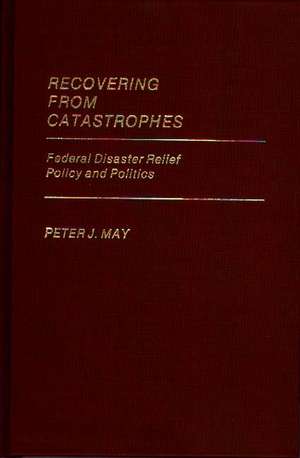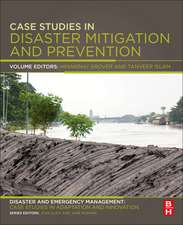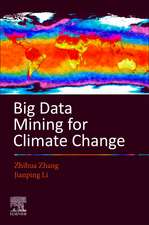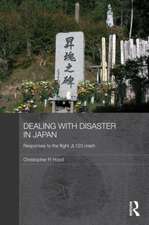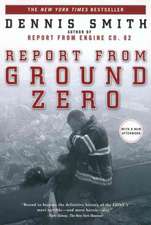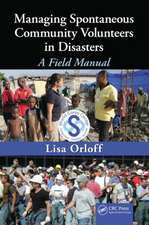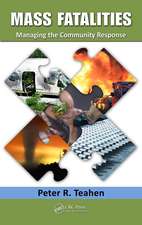Recovering from Catastrophes: Federal Disaster Relief Policy and Politics: Contributions in Political Science, cartea 128
Autor Peter Mayen Limba Engleză Hardback – 6 iun 1985
This book examines the evolution of federal disaster relief policy, assesses problems with current policy, and provides an understanding of the issues likely to be involved in future deliberations about federal policy. While examining its formulation, May describes this policy making in two different political environments: the charged atmosphere immediately following the catastrophe and, secondly, the calm between catastrophes. Local, state, and federal government conflicts are illustrated in a case study of Mount St. Helens; intergovernmental partnerships in this arena are discussed in relation to other relief efforts. May stresses the political implications of disaster relief in his analysis of the electoral benefits and influence politicians derive from their attempts to influence federal disaster relief efforts. Finally he addresses the economic considerations and future directions for federal disaster relief policy. Three distinct policy approaches and their tradeoffs provide an overview of the options for future policy making.
Din seria Contributions in Political Science
- 35%
 Preț: 460.51 lei
Preț: 460.51 lei - 51%
 Preț: 300.97 lei
Preț: 300.97 lei - 23%
 Preț: 171.48 lei
Preț: 171.48 lei - 24%
 Preț: 464.24 lei
Preț: 464.24 lei - 33%
 Preț: 320.60 lei
Preț: 320.60 lei - 38%
 Preț: 439.77 lei
Preț: 439.77 lei - 27%
 Preț: 439.01 lei
Preț: 439.01 lei - 24%
 Preț: 465.40 lei
Preț: 465.40 lei - 38%
 Preț: 442.13 lei
Preț: 442.13 lei - 43%
 Preț: 297.08 lei
Preț: 297.08 lei - 38%
 Preț: 439.51 lei
Preț: 439.51 lei - 41%
 Preț: 328.13 lei
Preț: 328.13 lei - 42%
 Preț: 302.78 lei
Preț: 302.78 lei - 53%
 Preț: 381.77 lei
Preț: 381.77 lei - 38%
 Preț: 440.61 lei
Preț: 440.61 lei - 53%
 Preț: 367.93 lei
Preț: 367.93 lei - 42%
 Preț: 269.23 lei
Preț: 269.23 lei - 51%
 Preț: 304.19 lei
Preț: 304.19 lei - 52%
 Preț: 247.18 lei
Preț: 247.18 lei - 42%
 Preț: 321.02 lei
Preț: 321.02 lei - 43%
 Preț: 414.79 lei
Preț: 414.79 lei - 33%
 Preț: 321.44 lei
Preț: 321.44 lei - 52%
 Preț: 248.87 lei
Preț: 248.87 lei - 28%
 Preț: 362.62 lei
Preț: 362.62 lei - 23%
 Preț: 471.57 lei
Preț: 471.57 lei - 33%
 Preț: 320.31 lei
Preț: 320.31 lei - 34%
 Preț: 368.07 lei
Preț: 368.07 lei - 38%
 Preț: 206.27 lei
Preț: 206.27 lei - 38%
 Preț: 437.47 lei
Preț: 437.47 lei - 38%
 Preț: 438.00 lei
Preț: 438.00 lei - 38%
 Preț: 437.31 lei
Preț: 437.31 lei - 38%
 Preț: 345.49 lei
Preț: 345.49 lei - 38%
 Preț: 437.31 lei
Preț: 437.31 lei - 38%
 Preț: 436.99 lei
Preț: 436.99 lei - 38%
 Preț: 346.67 lei
Preț: 346.67 lei - 50%
 Preț: 305.89 lei
Preț: 305.89 lei - 38%
 Preț: 442.73 lei
Preț: 442.73 lei - 42%
 Preț: 252.57 lei
Preț: 252.57 lei - 38%
 Preț: 345.74 lei
Preț: 345.74 lei - 31%
 Preț: 284.72 lei
Preț: 284.72 lei - 27%
 Preț: 440.03 lei
Preț: 440.03 lei - 55%
 Preț: 150.08 lei
Preț: 150.08 lei - 31%
 Preț: 436.80 lei
Preț: 436.80 lei - 33%
 Preț: 321.35 lei
Preț: 321.35 lei - 38%
 Preț: 437.40 lei
Preț: 437.40 lei - 14%
 Preț: 355.15 lei
Preț: 355.15 lei - 28%
 Preț: 374.56 lei
Preț: 374.56 lei - 42%
 Preț: 252.00 lei
Preț: 252.00 lei - 27%
 Preț: 438.41 lei
Preț: 438.41 lei
Preț: 364.06 lei
Preț vechi: 501.84 lei
-27% Nou
69.68€ • 75.72$ • 58.57£
Carte tipărită la comandă
Livrare economică 22 aprilie-06 mai
Specificații
ISBN-10: 031324698X
Pagini: 186
Dimensiuni: 156 x 234 x 13 mm
Greutate: 0.46 kg
Editura: Greenwood Press
Colecția Praeger
Seria Contributions in Political Science
